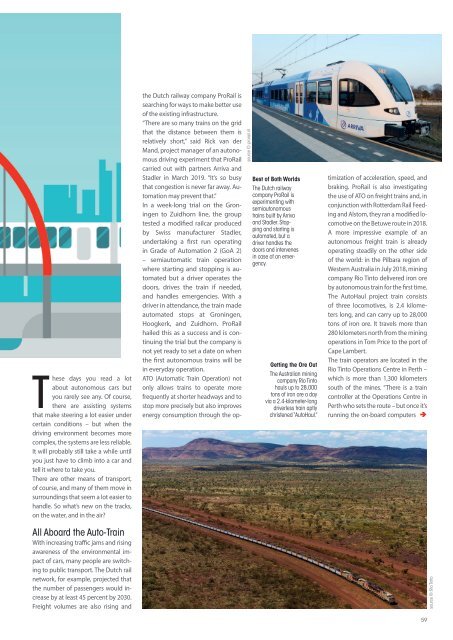Smart Industry 1/2019
Smart Industry 1/2019 - The IoT Business Magazine - powered by Avnet Silica
Smart Industry 1/2019 - The IoT Business Magazine - powered by Avnet Silica
Create successful ePaper yourself
Turn your PDF publications into a flip-book with our unique Google optimized e-Paper software.
These days you read a lot<br />
about autonomous cars but<br />
you rarely see any. Of course,<br />
there are assisting systems<br />
that make steering a lot easier under<br />
certain conditions – but when the<br />
driving environment becomes more<br />
complex, the systems are less reliable.<br />
It will probably still take a while until<br />
you just have to climb into a car and<br />
tell it where to take you.<br />
There are other means of transport,<br />
of course, and many of them move in<br />
surroundings that seem a lot easier to<br />
handle. So what’s new on the tracks,<br />
on the water, and in the air?<br />
All Aboard the Auto-Train<br />
With increasing traffic jams and rising<br />
awareness of the environmental impact<br />
of cars, many people are switching<br />
to public transport. The Dutch rail<br />
network, for example, projected that<br />
the number of passengers would increase<br />
by at least 45 percent by 2030.<br />
Freight volumes are also rising and<br />
source ©: prorail.nl<br />
Best of Both Worlds<br />
The Dutch railway<br />
company ProRail is<br />
experimenting with<br />
semiautonomous<br />
trains built by Arriva<br />
and Stadler. Stopping<br />
and starting is<br />
automated, but a<br />
driver handles the<br />
doors and intervenes<br />
in case of an emergency.<br />
Getting the Ore Out<br />
The Australian mining<br />
company Rio Tinto<br />
hauls up to 28,000<br />
tons of iron ore a day<br />
via a 2.4-kilometer-long<br />
driverless train aptly<br />
christened “AutoHaul.”<br />
the Dutch railway company ProRail is<br />
searching for ways to make better use<br />
of the existing infrastructure.<br />
“There are so many trains on the grid<br />
that the distance between them is<br />
relatively short,” said Rick van der<br />
Mand, project manager of an autonomous<br />
driving experiment that ProRail<br />
carried out with partners Arriva and<br />
Stadler in March <strong>2019</strong>. “It’s so busy<br />
that congestion is never far away. Automation<br />
may prevent that.”<br />
In a week-long trial on the Groningen<br />
to Zuidhorn line, the group<br />
tested a modified railcar produced<br />
by Swiss manufacturer Stadler,<br />
undertaking a first run operating<br />
in Grade of Automation 2 (GoA 2)<br />
– semiautomatic train operation<br />
where starting and stopping is automated<br />
but a driver operates the<br />
doors, drives the train if needed,<br />
and handles emergencies. With a<br />
driver in attendance, the train made<br />
automated stops at Groningen,<br />
Hoogkerk, and Zuidhorn. ProRail<br />
hailed this as a success and is continuing<br />
the trial but the company is<br />
not yet ready to set a date on when<br />
the first autonomous trains will be<br />
in everyday operation.<br />
ATO (Automatic Train Operation) not<br />
only allows trains to operate more<br />
frequently at shorter headways and to<br />
stop more precisely but also improves<br />
energy consumption through the optimization<br />
of acceleration, speed, and<br />
braking. ProRail is also investigating<br />
the use of ATO on freight trains and, in<br />
conjunction with Rotterdam Rail Feeding<br />
and Alstom, they ran a modified locomotive<br />
on the Betuwe route in 2018.<br />
A more impressive example of an<br />
autonomous freight train is already<br />
operating steadily on the other side<br />
of the world: in the Pilbara region of<br />
Western Australia in July 2018, mining<br />
company Rio Tinto delivered iron ore<br />
by autonomous train for the first time.<br />
The AutoHaul project train consists<br />
of three locomotives, is 2.4 kilometers<br />
long, and can carry up to 28,000<br />
tons of iron ore. It travels more than<br />
280 kilometers north from the mining<br />
operations in Tom Price to the port of<br />
Cape Lambert.<br />
The train operators are located in the<br />
Rio Tinto Operations Centre in Perth –<br />
which is more than 1,300 kilometers<br />
south of the mines. “There is a train<br />
controller at the Operations Centre in<br />
Perth who sets the route – but once it’s<br />
running the on-board computers<br />
59<br />
source ©: Rio Tinto
















